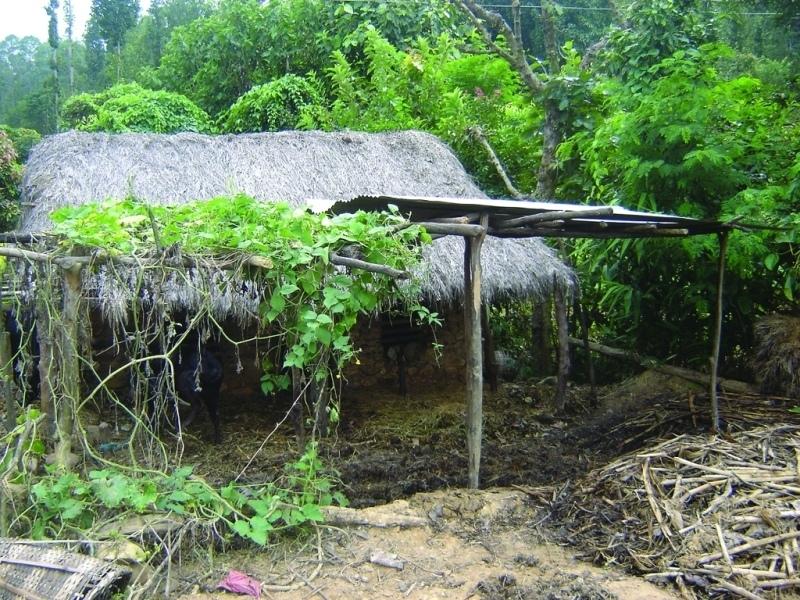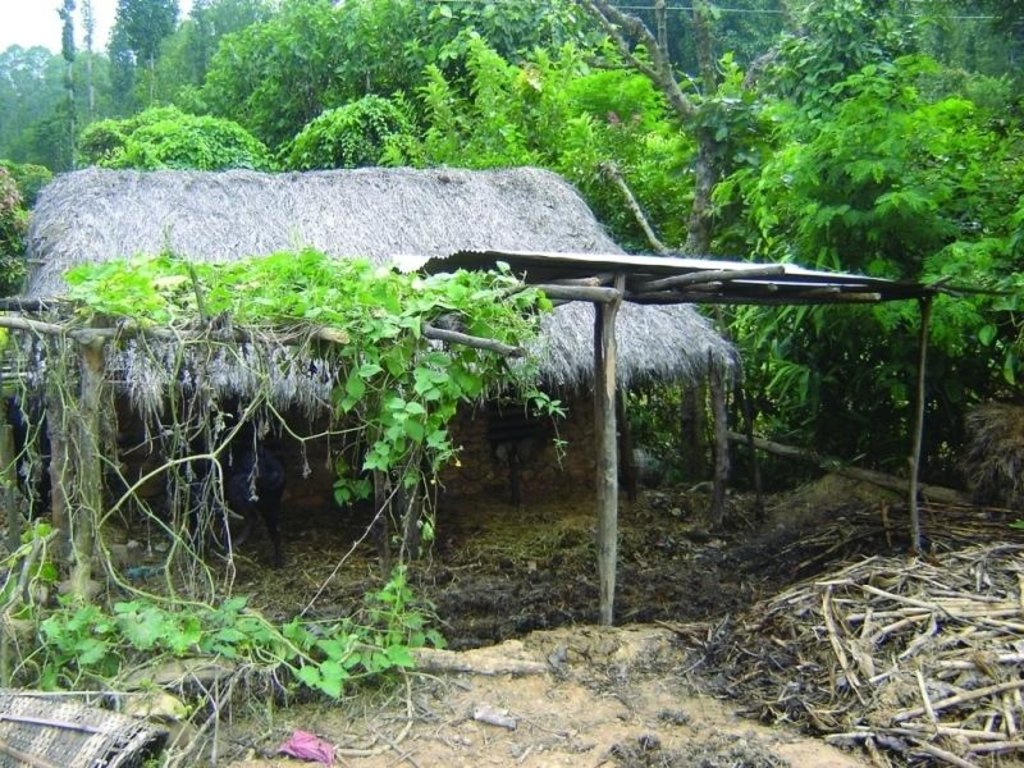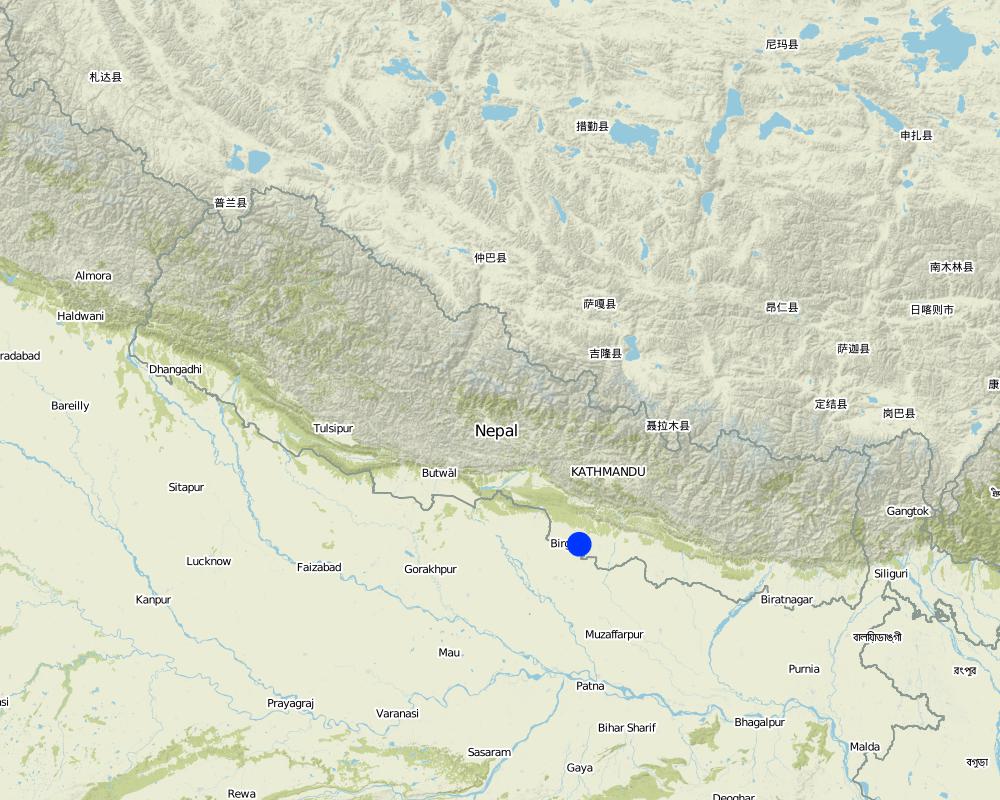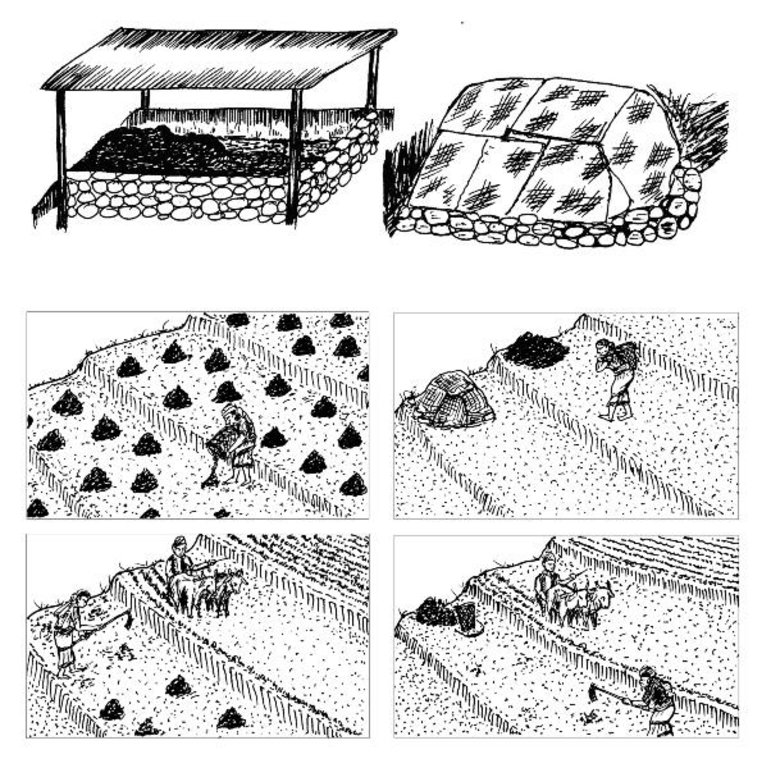Improved farmyard manure through sunlight, rain and runoff protection [Nepal]
- Criação:
- Atualização:
- Compilador/a: Richard Allen
- Editor: –
- Revisores: David Streiff, Alexandra Gavilano
Gham, bhalpani ra baleni bata bachai nirman gariyeko ramro gnastar ko gothemal (Nepali)
technologies_1756 - Nepal
Veja as seções
Expandir tudo Recolher tudo1. Informação geral
1.2 Detalhes do contato das pessoas capacitadas e instituições envolvidas na avaliação e documentação da tecnologia
Especialista em GST:
Director
Soil Management Directorate, Department of Agriculture
Nepal
Especialista em GST:
Team Leader
Sustainable Soil Management Programme
Nepal
Nome do projeto que facilitou a documentação/avaliação da Tecnologia (se relevante)
Sustainable Soil Management Programme, Nepal (SSMP)Nome da(s) instituição(ões) que facilitou(ram) a documentação/ avaliação da Tecnologia (se relevante)
Department of Agriculture, Soil Management Directorate, Hariharbhawan Lalitpur (doasoil) - NepalNome da(s) instituição(ões) que facilitou(ram) a documentação/ avaliação da Tecnologia (se relevante)
HELVETAS (Swiss Intercooperation)1.3 Condições em relação ao uso da informação documentada através de WOCAT
O/a compilador/a e a(s) pessoa(s) capacitada(s) aceitam as condições relativas ao uso de dados documentados através da WOCAT:
Sim
1.5 Referência ao(s) questionário(s) sobre abordagens GST (documentado(s) usando WOCAT)

Farmer field schools on integrated plant nutrient systems [Nepal]
Participatory and collaborative learning through the farmer field school approach
- Compilador/a: Richard Allen

Farmer-to-farmer diffusion [Nepal]
Wider diffusion of sustainable soil management technologies through a demand responsive farmer-to-farmer diffusion approach
- Compilador/a: Richard Allen
2. Descrição da tecnologia de GST
2.1 Descrição curta da tecnologia
Definição da tecnologia:
Improving farmyard manure by protecting it from direct sunlight, rainfall, and runoff to reduce volatilisation and leaching
2.2 Descrição detalhada da tecnologia
Descrição:
Farmyard manure is the most common form of organic fertiliser applied to crops in the midhills of Nepal. Farmyard manure has a high proportion of organic material which nurtures soil organisms and is essential for maintaining an active soil life. Typically, only about half of the nutrient content of farmyard manure becomes available for crop growth during the first year after it is applied to the soil. The rest of the nutrients are channelled through soil biotic processes and are released in the following years. The high organic matter content and the more active soil life improve or maintain a friable soil structure, increase the cation exchange capacity, the water holding capacity, and the infiltration rate, and reducing the risk of soil pests.
Indigenous methods of preparing and using farmyard manure vary depending on the ecological zone, access to bedding material from crop or forest land and to crop residues and fodder, the availability of labour, and other factors. Traditionally, Nepali farmers take the manure out of their sheds to dry it for 2-3 days and then carry it to the field where it is left in small heaps for a number of days before being spread and incorporated into the soil.
Farmers rate the quality of manure according to which livestock species it comes from. These ratings have been confirmed by nutrient analysis as cattle manure (NPK%: 0.6, 0.13, 0.66) is considered to be better than buffalo manure (0.33, 0.25, 0.10), and horse manure; while pig (0.5, 0.18, 0.42), goat (0.6, 0.13, 0.99), and sheep manure (0.6, 0.13, 0.99) are considered better than cattle manure. Chicken manure (1.46, 0.51, 0.51) is considered the best of all.
It has however been shown that considerable nutrient losses occur if the manure is inappropriately handled or stored. Drying of the manure leads to loss of nutrients through volatilisation, and rainfall and runoff leads to leaching or washing out of nutrients. In addition, the common disposal of urine - the part of the excreta with the highest nutrient concentration - further reduces the level of nutrients in manure.
To reduce nutrient losses farmyard manure needs to be protected from direct sunlight; protected from rainfall or run-on; and protected from runoff. This can be achieved in a variety of ways using a variety of inputs. It is most important to protect the manure during storage and just before it is applied in the field to make the best use of this valuable local resource.
2.3 Fotos da tecnologia
2.5 País/região/locais onde a tecnologia foi aplicada e que estão cobertos nesta avaliação
País:
Nepal
Especificação adicional de localização:
Midhills districts of Nepal
Especifique a difusão da tecnologia:
- Aplicado em pontos específicos/concentrado numa pequena área
Map
×3. Classificação da tecnologia de GST
3.1 Principal/principais finalidade(s) da tecnologia
- Improve manure
3.2 Tipo(s) atualizado(s) de uso da terra onde a tecnologia foi aplicada

Terra de cultivo
- Cultura anual
Comentários:
Major land use problems (compiler’s opinion): Intensifying cultivation practices with either 1) inadequate application of fertilisers leading to a decline in soil fertility and the mining of soil nutrients or 2) application of too much fertiliser causing environmental problems through excessive leaching, and losses of fertiliser in surface runoff and consequent eutrophication or nitrification of streams, ponds or groundwater
3.5 Grupo de GST ao qual pertence a tecnologia
- Gestão integrada de fertilidade do solo
3.6 Medidas de GST contendo a tecnologia

Medidas de gestão
- M2: Mudança de gestão/nível de intensidade
3.7 Principais tipos de degradação da terra abordados pela tecnologia

Deteriorização química do solo
- Cn: declínio de fertilidade e teor reduzido de matéria orgânica (não causado pela erosão)
3.8 Redução, prevenção ou recuperação da degradação do solo
Especifique o objetivo da tecnologia em relação a degradação da terra:
- Reduzir a degradação do solo
4. Especificações técnicas, implementação de atividades, entradas e custos
4.1 Desenho técnico da tecnologia
Especificações técnicas (relacionada ao desenho técnico):
a) Covering the farmyard manure with a roof made of tin sheet or plastic sheets. Cheaper alternatives are:
- a thatched roof
- shading with creepers like cucurbits
- planting broadleaf mustard on the heap
- applying a covering of crop residues or forest material
b) Farmyard manure is traditionally carried to the fi elds in doko baskets and left there in unprotected heaps to be incorporated often weeks and sometimes several months later (top and bottom left). It is much better to incorporate it on the day of transport as the longer it is left out on the fi elds in heaps the greater are the nutrient losses from the heaps (bottom right). Alternatively it can be stored in a corner of the fi eld covered with plastic sheets, crop residues, or in some other way (top right).
Technical knowledge required for field staff / advisors: low
Technical knowledge required for land users: low
Main technical functions: increase in organic matter, increase in soil fertility, increase in soil productivity
Secondary technical functions: increased infiltration rate and water holding capacity, improved soil physical properties (friability,easier soil preparation)
Layout change according to natural and human environment: protect farmyard manure; change application
4.2 Informação geral em relação ao cálculo de entradas e custos
Especifique a moeda utilizada para os cálculos de custo:
- USD
Indique a média salarial da mão-de-obra contratada por dia:
2.00
4.3 Atividades de implantação
| Atividade | Periodicidade (estação do ano) | |
|---|---|---|
| 1. | Cover the farmyard manure heap or pit with any available material (crop residues, forest material, plastic sheet, thatched roof, zinc sheet, etc.) |
4.4 Custos e entradas necessárias para a implantação
| Especifique a entrada | Unidade | Quantidade | Custos por unidade | Custos totais por entrada | % dos custos arcados pelos usuários da terra | |
|---|---|---|---|---|---|---|
| Mão-de-obra | Building manure pit and shelter | Persons/day | 1,0 | 2,0 | 2,0 | 100,0 |
| Material de construção | Material | unit | 1,0 | 25,0 | 25,0 | 100,0 |
| Custos totais para a implantação da tecnologia | 27,0 | |||||
| Custos totais para o estabelecimento da Tecnologia em USD | 27,0 | |||||
4.5 Atividades recorrentes/manutenção
| Atividade | Periodicidade/frequência | |
|---|---|---|
| 1. | Pour household wastewater onto the heap or pit to keep the farmyard |
4.6 Custos e entradas necessárias pata a manutenção/atividades recorrentes (por ano)
Comentários:
Cost as in January 2007
5. Ambiente natural e humano
5.1 Clima
Precipitação pluviométrica anual
- <250 mm
- 251-500 mm
- 501-750 mm
- 751-1.000 mm
- 1.001-1.500 mm
- 1.501-2.000 mm
- 2.001-3.000 mm
- 3.001-4.000 mm
- > 4.000 mm
Especificações/comentários sobre a pluviosidade:
Annual rainfall: Also 2000-3000 mm
Zona agroclimática
- úmido
Thermal climate class: subtropics
5.2 Topografia
Declividade média:
- Plano (0-2%)
- Suave ondulado (3-5%)
- Ondulado (6-10%)
- Moderadamente ondulado (11-15%)
- Forte ondulado (16-30%)
- Montanhoso (31-60%)
- Escarpado (>60%)
Formas de relevo:
- Planalto/planície
- Cumes
- Encosta de serra
- Encosta de morro
- Sopés
- Fundos de vale
Zona de altitude:
- 0-100 m s.n.m.
- 101-500 m s.n.m.
- 501-1.000 m s.n.m.
- 1.001-1.500 m s.n.m.
- 1.501-2.000 m s.n.m.
- 2.001-2.500 m s.n.m.
- 2.501-3.000 m s.n.m.
- 3.001-4.000 m s.n.m.
- > 4.000 m s.n.m.
Comentários e outras especificações sobre a topografia:
Slopes on average: Also moderate (6-10%), rolling (11-15%) and hilly (16-30%)
Landforms: Also footslopes
Altitudinal zone: Also 1000-1500 m a.s.l., 1500-2000 m a.s.l. and 2000-2500 m a.s.l.
5.6 Características dos usuários da terra que utilizam a tecnologia
Orientação de mercado do sistema de produção:
- Subsistência (autoabastecimento)
- misto (subsistência/comercial)
Indivíduos ou grupos:
- Indivíduo/unidade familiar
Indique outras características relevantes dos usuários da terra:
Off-farm income specification: In most farm households, off-farm income plays at least a minor and increasingly a major role. Occasional opportunities for off-farm income present themselves in the form of daily labour wages. Some households’ members receive regular salaries, whilst an increasing number of Nepalis are working in India, the Middle East, Malaysia, and elsewhere and sending remittance incomes home.
Market orientation of production system: Also commercial/ market
5.7 Área média de terrenos utilizados pelos usuários de terrenos que aplicam a Tecnologia
- < 0,5 ha
- 0,5-1 ha
- 1-2 ha
- 2-5 ha
- 5-15 ha
- 15-50 ha
- 50-100 ha
- 100-500 ha
- 500-1.000 ha
- 1.000-10.000 ha
- > 10.000 ha
5.8 Propriedade de terra, direitos de uso da terra e de uso da água
Propriedade da terra:
- Indivíduo, não intitulado
- Indivíduo, intitulado
Direitos do uso da terra:
- Arrendado
- Indivíduo
Comentários:
Sharecropping between owner and tenant
6. Impactos e declarações finais
6.1 Impactos no local mostrados pela tecnologia
Impactos socioeconômicos
Produção
Produção agrícola
Renda e custos
Despesas com insumos agrícolas
Comentários/especificar:
Reduced expenditure on mineral fertilisers
Impactos ecológicos
Outros impactos ecológicos
Soil characteristics
6.2 Impactos externos mostrados pela tecnologia
Poluição de água subterrânea/rio
Comentários/especificar:
Reduction of nutrient influx into water bodies
Dependence on outside inputs
6.4 Análise do custo-benefício
Como os benefícios se comparam aos custos de implantação (do ponto de vista dos usuários da terra)?
Retornos a curto prazo:
positivo
Retornos a longo prazo:
positivo
Como os benefícios se comparam aos custos recorrentes/de manutenção(do ponto de vista dos usuários da terra)?
Retornos a curto prazo:
positivo
Retornos a longo prazo:
positivo
Comentários:
Large short- and long-term benefits due to need to use less of the costly mineral fertilisers. The only extra ‘cost’ is the extra labor needed.
6.5 Adoção da tecnologia
Comentários:
Comments on acceptance with external material support: An independent assessment found that 95% of the farmers participating in SSMP’s farmyard improvement activities were accepted the technology.
Comments on adoption trend: About 70% of non-participant farmers who had come into contact with the technologies had also adopted them.
6.7 Pontos fortes/vantagens/oportunidades da tecnologia
| Pontos fortes/vantagens/oportunidades na visão do/a compilador/a ou de outra pessoa capacitada |
|---|
|
The use of improved farmyard manure reduced the need for mineral fertiliser thereby reducing production costs and outside dependency How can they be sustained / enhanced? Further promotion of the technology will increase this impact |
| A simple technology affordable by poor farmers in remote areas far from a roadhead |
| The increased use of organic fertiliser improves the physical characteristics of soil making ploughing easier and increasing water holding capacity of the soil |
6.8 Pontos fracos, desvantagens/riscos da tecnologia e formas de superá-los
| Pontos fracos/vantagens/riscos na visão do/a compilador/a ou de outra pessoa capacitada | Como eles podem ser superados? |
|---|---|
| Cost of a permanent roof for the manure heap may hinder adoption of the technology | Promote simple alternatives to high cost roofs such as straw cover, cover with broad leaf mustard, thatch, and waste plastic |
7. Referências e links
7.1 Métodos/fontes de informação
7.2 Referências às publicações disponíveis
Título, autor, ano, ISBN:
STSS; SSMP (2001) Farmyard Manure and Compost Management (in Nepali) Kathmandu: Soil Testing Services Section, Department of Agriculture and Sustainable Soil Management Programme
Disponível de onde? Custos?
SSMP
Links e módulos
Expandir tudo Recolher tudoLinks

Farmer field schools on integrated plant nutrient systems [Nepal]
Participatory and collaborative learning through the farmer field school approach
- Compilador/a: Richard Allen

Farmer-to-farmer diffusion [Nepal]
Wider diffusion of sustainable soil management technologies through a demand responsive farmer-to-farmer diffusion approach
- Compilador/a: Richard Allen
Módulos
Não há módulos





